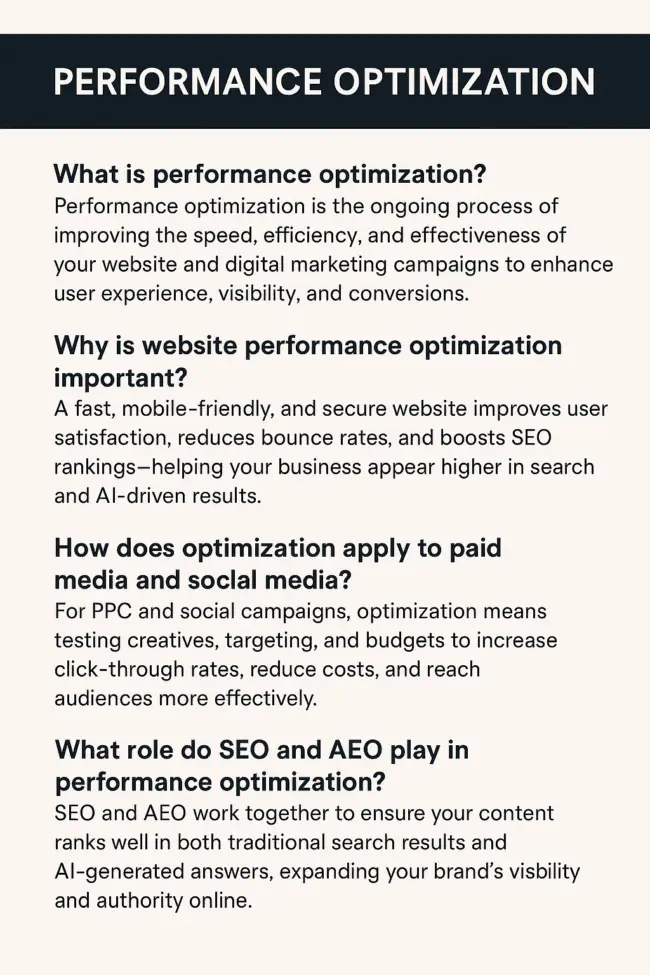Performance Optimization - The Puzzle Pieces
What is performance optimization?
Performance optimization is the ongoing process of improving the speed, efficiency, and effectiveness of your website and digital marketing campaigns to enhance user experience, visibility, and conversions.
Why is website performance optimization important?
A fast, mobile-friendly, and secure website improves user satisfaction, reduces bounce rates, and boosts SEO rankings—helping your business appear higher in search and AI-driven results.
How does performance optimization use analytics
Analytics track KPIs like conversion rate, bounce rate, and user engagement to identify weak points and opportunities, allowing for data-driven improvements that lead to measurable growth.
How does optimization apply to paid media and social media?
For PPC and social campaigns, optimization means testing creatives, targeting, and budgets to increase click-through rates, reduce costs, and reach audiences more effectively.
What role do SEO and AEO play in performance optimization?
SEO and AEO work together to ensure your content ranks well in both traditional search results and AI-generated answers, expanding your brand’s visibility and authority online.
 Performance optimization is a continuous process of refining how your website, applications, and digital marketing campaigns function to deliver the best possible results for users and search engines. It’s about maximizing efficiency—making your digital presence faster, smoother, and more effective at converting visitors into customers. A high-performing site or campaign doesn’t just look good; it loads quickly, responds intuitively, and drives measurable business outcomes such as leads, sales, and engagement.
Performance optimization is a continuous process of refining how your website, applications, and digital marketing campaigns function to deliver the best possible results for users and search engines. It’s about maximizing efficiency—making your digital presence faster, smoother, and more effective at converting visitors into customers. A high-performing site or campaign doesn’t just look good; it loads quickly, responds intuitively, and drives measurable business outcomes such as leads, sales, and engagement.
Digital marketing is like a puzzle, and performance optimization is the puzzle assembled – no missing pieces allowed. For your website, it involves improving technical elements like page load speed, mobile responsiveness, image compression, clean code, and secure hosting. These technical enhancements not only improve user experience but also signal quality to search engines, boosting SEO rankings. When combined with AEO (Answer Engine Optimization), it ensures your site is optimized for both search algorithms and AI-driven engines like Google’s SGE or ChatGPT Search, helping your content appear in summarized, voice, or AI-generated answers.
On the analytics side, performance optimization means tracking key performance indicators (KPIs) such as conversion rate, bounce rate, and page dwell time to identify where users drop off or what content performs best. Data-driven adjustments—like refining landing pages, improving calls to action, or personalizing content—turn insights into growth.
For paid media, performance optimization focuses on improving ad efficiency through A/B testing, better targeting, and more innovative bidding strategies. In PPC campaigns, that might mean reallocating budget to high-converting keywords or improving ad copy to boost click-through rates while reducing cost per acquisition.
Social media involves testing post timing, creative formats, and engagement strategies to reach audiences more effectively. For content marketing, it means continuously reviewing how well articles, blogs, and videos perform and updating them for better readability, SEO relevance, and conversion flow.
Ultimately, performance optimization is not a one-time task—it’s an ongoing cycle of testing, measuring, and improving. By aligning technical SEO, AEO, analytics, content, and advertising strategies, your business creates a finely tuned ecosystem designed for both visibility and growth. It ensures every puzzle piece of your digital marketing strategy is fitting together efficiently, giving you a competitive edge and delivering stronger, measurable results over time.